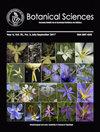黄中心丝菌(Fabeae,Papilioideae),墨西哥尤卡坦半岛的一个新种
IF 0.7
4区 生物学
Q3 PLANT SCIENCES
引用次数: 0
摘要
背景:中心虫(Fabaceae)在新大陆有35-44种,在墨西哥有10种,在尤卡坦半岛有9种。大多数物种都有三小叶和双色花。单小叶是一种罕见的特征,在少数物种中也有发现,例如C.sagittum(Humb.&Bonpl.ex Willd.)Brandegee,但单色花,例如缺乏花蜜引导,甚至是一种更不寻常的特征状态。尤卡坦半岛的几个Centrosema种群具有这两种特征状态,这一组合使它们与该属的其他成员不同。问题:尤卡坦半岛的中心体有单小叶、有翼叶柄和单色花,是一种与表型相似的箭形花不同的物种吗?研究种:中心花属(花科,蝶形花科)。研究地点和日期:墨西哥尤卡坦半岛,2021-2023年。方法:通过查阅相关文献、检索资料和查阅植物学文献,对植物标本进行分类测定。利用国际自然保护联盟的方法对新物种的保护状况进行了评估。结果:收集到的标本确实代表了一个未被描述的物种,它与箭状中心虫的不同之处在于其较小的乳黄色单色花朵。该物种被评估为濒危物种(EN)。结论:本文报道了一个新种,产于尤卡坦半岛。墨西哥目前已确认有11种Centrosema,尤卡坦半岛有9种。射手座C.在尤卡坦半岛没有出现。本文章由计算机程序翻译,如有差异,请以英文原文为准。
Centrosema flavescens (Fabaceae, Papilionoideae), a new species from the Yucatan Peninsula, Mexico
Background: Centrosema (Fabaceae) includes 35-44 species in the New World, 10 in Mexico, and 9 in the Yucatan Peninsula. Most species have trifoliolate leaves and bicolored flowers. Unifoliolate leaves are an infrequent character that is found in a few species, e.g., C. sagittatum (Humb. & Bonpl. ex Willd.) Brandegee, but monochromatic flowers, e.g, lacking nectar guides, is even a more unusual character state. Several populations of a Centrosema from the Yucatan Peninsula share both character states, a combination that sets them apart from other members of the genus.
Question: Is the Centrosema with unifoliolate leaves, alate petioles, and monochromatic flowers of the Yucatan Peninsula, a species distinct from the phenetically similar C. sagittatum?
Studies species: Centrosema (Fabaceae, Papilionoideae).
Study site and dates: Yucatan Peninsula, Mexico, 2021-2023.
Methods: Botanical specimens were collected and determined taxonomically through the use of relevant literature, keys, and the consulting of botanical collections. The conservation status of the new species was assessed using the IUCN methodology.
Results: The specimens collected do represent an undescribed species that differs from Centrosema sagittatum by its smaller, cream-yellow, monochromatic flowers. The species is assessed as Endangered (EN).
Conclusions: A new species, Centrosema flavescens from the Yucatan Peninsula is proposed. Eleven species of Centrosema are now recognized in Mexico, nine in the Yucatan Peninsula. C. sagittatum does not occur in the Yucatan peninsula.
求助全文
通过发布文献求助,成功后即可免费获取论文全文。
去求助
来源期刊

Botanical Sciences
Agricultural and Biological Sciences-Plant Science
CiteScore
1.90
自引率
21.40%
发文量
71
审稿时长
16 weeks
期刊介绍:
Botanical Sciences welcomes contributions that present original, previously unpublished results in Botany, including disciplines such as ecology and evolution, structure and function, systematics and taxonomy, in addition to other areas related to the study of plants. Research reviews are also accepted if they summarize recent advances in a subject, discipline, area, or developmental trend of botany; these should include an analytical, critical, and interpretative approach to a specific topic. Acceptance for reviews will be evaluated first by the Review Editor. Opinion Notes and Book Reviews are also published as long as a relevant contribution in the study of Botany is explained and supported.
 求助内容:
求助内容: 应助结果提醒方式:
应助结果提醒方式:


